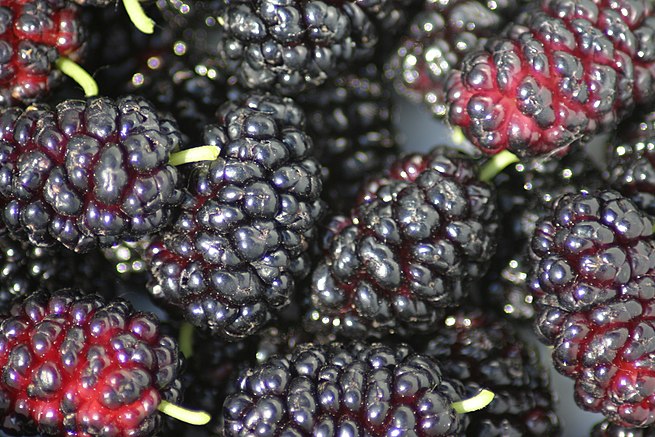
-
Mulberry
Morus, a genus of flowering plants in the family Moraceae, comprises 10–16 species of deciduous trees commonly known as mulberries, growing wild and under cultivation in many temperate world regions.The closely related genus Broussonetia is also commonly known as mulberry, notably the paper mulberry, Broussonetia papyrifera.Mulberries are fast-growing when young, but soon become slow-growing and rarely exceed 10–15 metres (30–50 ft) tall. The leaves are alternately arranged, simple and often lobed and serrated on the margin. Lobes are more common on juvenile shoots than on mature trees. The trees can be monoecious or dioecious. The mulberry fruit is a multiple fruit, approximately 2–3 cm (3⁄4–1 1⁄4 in) long. Immature fruits are white, green, or pale yellow. In most species the fruits turn pink and then red while ripening, then dark purple or black, and have a sweet flavor when fully ripe. The fruits of the white-fruited cultivar are white when ripe; the fruit of this cultivar is also sweet, but has a mild flavor compared with darker varieties. Although quite similar looking, they are not to be confused with blackberries.
-
Sycamine
The sycamine tree (Greek: συκάμινος sykaminοs) is a tree mentioned in both classical Hebrew literature (Isaiah 9:9; Mishnah Demai 1:1, et al.) and in Greek literature. The tree is also known by the names Sycamore fig tree (Ficus sycomorus), and fig-mulberry. It appears also in Luke 17:6 and 19:4 of the Christian Bible. The Hebrew word for the tree is shiḳmah (sing.) (Hebrew: שקמה), shiḳmīn (pl.) (Hebrew: שקמין), having nearly the same phonemes in Greek (συκομορέα sykomorea) Others, however, identify the tree as mulberry tree, found in two species, the black mulberry (Morus nigra) and the white mulberry (Morus alba), which are common in Palestine. It is in the same family as the fig-tree.
The bricks are fallen, but we will build with hewn stones; the sycamores are cut down, but cedars will we put in their place.
The trees were once very common along the lowlands and coastal plains of Israel. During the Second Temple period, sycamore fig trees grew in Jericho, but when passers-by would come along and appropriate the tree branches unto themselves, the owners came and dedicated the trees, in their entirety, to the Temple treasury as a dedicatory offering in order to prevent their theft.The sycamine is a deciduous to semi-deciduous tree and sheds its fruit in a prolific manner, by reason of which the Sages of Israel prohibited a Jewish planter from planting such trees within the radius of 50 cubits from his neighbor’s cistern.All sycamines that currently grow in the Land of Israel (Ficus sycomorus) are believed to be invasive species, but which are now cultivated in Israel. The tree is native to East Africa. It is thought that the species was once endemic to the Land of Israel. Another species of sycamine endemic to the Horn of Africa, Ethiopia and Yemen is Ficus vasta.
-
Mulberry (noun)
Any of several trees, of the genus Morus, having edible fruits.
-
Mulberry (noun)
The fruit of this tree.
-
Mulberry (noun)
A dark purple colour tinted with red.
“color panel|78184A”
-
Mulberry (adjective)
Of a dark purple colour tinted with red.
-
Sycamine (noun)
A tree, mentioned in Luke’s Gospel, and thought to be the black mulberry.
“sycamore”
